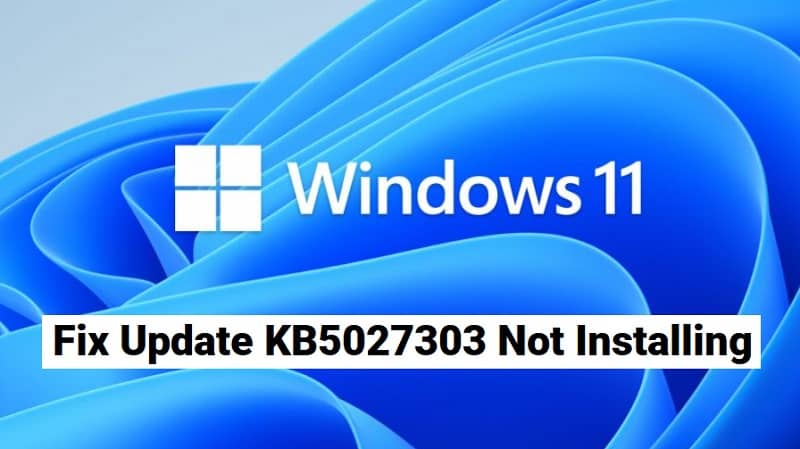Two days back Microsoft released the latest KB5027303 update for Windows 11, version 22H2, all editions. The update brings a lot of new features to the Windows 11 PC including notification badging for Microsoft accounts, improvements to sharing of a local file in File Explorer with Microsoft Outlook contacts, and live captions for a number of more languages etc. But, it appears that many users are facing an issue with installing and downloading the latest KB5027303 update on their PC.
In this article, we will provide you with a step-by-step guide to help you fix the issue and successfully install the KB5027303 update on your Windows 11 computer.
Before we dive into the troubleshooting steps, let’s understand the importance of the KB5027303 update. This update is designed to improve the stability, performance, and security of your Windows 11 operating system. It contains bug fixes, security patches, and enhancements to ensure a smooth and secure computing experience. However, if you’re unable to install or download this update, it can hinder your system’s performance and leave it vulnerable to security threats.
How to Fix Update KB5027303 Not Installing/Downloading on Windows 11?
If you’re also facing issues with the KB5027303 update not installing or downloading on your Windows 11 system, you’re not alone. Many users have encountered this problem, but fortunately, there are several troubleshooting steps you can take to resolve it.
2. Check Your Internet Connection
A stable and reliable internet connection is crucial for downloading updates. Before proceeding with any troubleshooting steps, ensure that your internet connection is working properly. Check if other websites and online services are accessible. If you’re using a Wi-Fi connection, try switching to a wired connection temporarily to rule out any wireless connectivity issues.
3. Restart Your Computer
Sometimes, a simple restart can resolve update installation issues. Restart your computer and attempt to install the KB5027303 update again. This simple step can help clear any temporary glitches and errors that might be causing the problem.
4. Run Windows Update Troubleshooter
Windows 11 includes a built-in troubleshooter specifically designed to fix update-related issues. Here’s how you can run the Windows Update Troubleshooter:
- Step 1: Press the Windows key on your keyboard and type “Troubleshoot” in the search bar.
- Step 2: Select the “Troubleshoot settings” option from the search results.
- Step 3: Scroll down and click on “Additional troubleshooters”.
- Step 4: Locate the “Windows Update” troubleshooter and click on it.
- Step 5: Click the “Run the troubleshooter” button and follow the on-screen instructions.
Once the troubleshooter completes its scan, it will attempt to fix any problems found with Windows Update.
Also Read: How to Fix Update KB5027231/KB5027119 Not Installing/Downloading on Windows 11
5. Clear Windows Update Cache
Clearing the Windows Update cache can help resolve update installation issues. Follow these steps to clear the cache:
- Step 1: Press the Windows key + R on your keyboard to open the Run dialog box.
- Step 2: Type “services.msc” and press Enter to open the Services window.
- Step 3: Scroll down and locate the “Windows Update” service.
- Step 4: Right-click on it and select “Stop” to halt the service temporarily.
- Step 5: Open File Explorer and navigate to C:\Windows\SoftwareDistribution.
Step 6: Select all the files and folders inside the SoftwareDistribution folder and delete them. Note that you may need administrator rights to perform this action.
Step 7: Go back to the Services window, right-click on the “Windows Update” service, and select “Start” to restart the service.
Now try installing the KB5027303 update and see if the issue is resolved.
6. Disable Antivirus and Firewall Temporarily
Sometimes, antivirus or firewall software can interfere with the update process. Temporarily disabling these security measures can help determine if they are causing the issue. Remember to enable them after the update installation is complete.
7. Reset Windows Update Components
Resetting Windows Update components can often fix update-related problems. Here’s how you can do it:
Step 1: Open the Command Prompt as an administrator.
- Press the Windows key on your keyboard or click on the Start button in the taskbar.
- In the search bar, type “Command Prompt”.
- From the search results, click on the Command Prompt app or select Command Prompt from the list.
Step 2: Type the following commands one by one and press Enter after each:
- net stop wuauserv
- net stop cryptsvc
- net stop bits
- net stop msiserver
- ren C:\Windows\SoftwareDistribution SoftwareDistribution.old
- ren C:\Windows\System32\catroot2 catroot2.old
- net start wuauserv
- net start cryptSvc
- net start bits
- net start msiserver
Step 3: Close the Command Prompt and try installing the update again.
8. Manually Download and Install the Update
If all else fails, you can manually download the KB5027303 update from the Microsoft Update Catalog and install it on your system. Follow these steps:
Step 1: Visit the Microsoft Update Catalog website.
Step 2: In the search bar, type “KB5027303” and press Enter.
Step 3: Locate the appropriate update for your system architecture and click on the “Download” button next to it.
Step 4: Once the update is downloaded, double-click on the file to begin the installation process.
Follow the on-screen instructions to complete the installation.
9. Perform a System Restore
If none of the previous steps worked, you can try performing a system restore to revert your Windows 11 system to a previous state when the update was working fine. System restore allows you to roll back your system settings, drivers, and registry to a specific point in time.
- Step 1: Press the Windows key on your keyboard and type “System Restore” in the search bar.
- Step 2: Select the “Create a restore point” option from the search results.
- Step 3: In the System Properties window, click on the “System Restore” button.
- Step 4: Follow the on-screen instructions to choose a restore point and initiate the system restore process.
Remember that system restore will undo any system changes made after the selected restore point.
10. Use Media Creation Tool
- Visit the Microsoft website and download the Media Creation Tool.
- Run the Media Creation Tool executable file.
- When prompted, select the “Create installation media for another PC” option and click “Next.”
- Choose the desired language, edition, and architecture (32-bit or 64-bit) for the Windows installation.
- Select the “USB flash drive” option and insert a USB drive with sufficient storage capacity.
- Click “Next” and follow the on-screen instructions to create the bootable USB drive.
- Once the USB drive is ready, restart your computer and boot from the USB drive.
- When the Windows installation screen appears, select your language and other preferences, and click “Next.”
- On the next screen, click on “Repair your computer” at the bottom left corner.
- Choose “Troubleshoot” from the recovery options menu.
- Select “Advanced options” and then click on “Command Prompt.”
- The Command Prompt window will open, allowing you to execute commands and perform troubleshooting tasks.
Conclusion
If you’re experiencing issues with the KB5027303 update not installing or downloading, the troubleshooting steps outlined in this article can help you resolve the problem. By following these steps, you can overcome the installation obstacles and ensure that your Windows 11 operating system is up to date.
FAQs
Q1. Why is the KB5027303 update not installing on my Windows 11 system?
There can be several reasons for the KB5027303 update not installing, such as internet connection issues, corrupted Windows Update components, conflicts with antivirus or firewall software, or other underlying system problems. By following the troubleshooting steps mentioned in this article, you can identify and resolve the specific cause affecting your system.
Q2. Can I skip the KB5027303 update and install future updates directly?
It is generally recommended to install all available updates, including the KB5027303 update, as they often contain important bug fixes, security patches, and performance improvements. Skipping updates can leave your system vulnerable to security threats and may cause compatibility issues with future updates.
Q3. Are the troubleshooting steps applicable to other Windows updates as well?
Yes, the troubleshooting steps mentioned in this article can be applied to other Windows updates that are not installing or downloading correctly. These steps are designed to address common issues related to Windows Update and can help resolve update installation problems in general.
Q4. Is it necessary to create a system restore point before attempting the troubleshooting steps?
Creating a system restore point is optional but highly recommended. It allows you to revert your system to a previous state if any issues arise during the troubleshooting process. Having a restore point provides an additional layer of protection and allows you to undo any changes made during the troubleshooting.
Q5. What should I do if none of the troubleshooting steps work?
If none of the troubleshooting steps mentioned in this article resolve the issue, it is advisable to seek further assistance from Microsoft support or consult with a professional technician. They can provide specialized guidance and help you diagnose and fix the problem.








